Vriesea philippo-coburgi
Click thumbnails for full size, scaled to a new window.
Vriesea philippo-coburgi
Note: The Taxon list spells this as "philippo-coburgi" (hyphen and one 'i')
The BSD (and several older documents) spells it "philippocoburgii" (no hyphen, double 'ii')
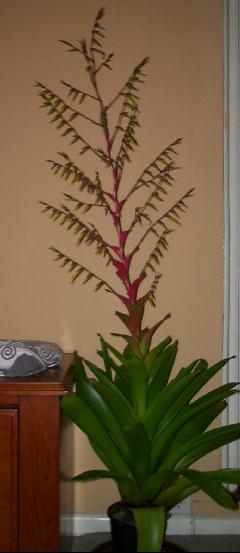
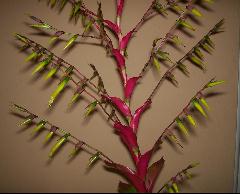
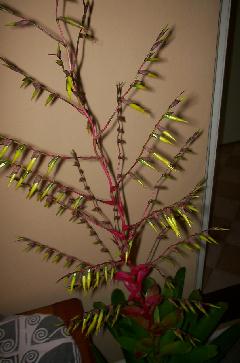
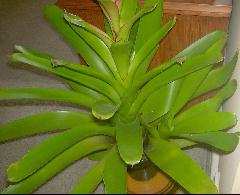
| Ian Hook 05/03, from BSA Spring Show '03 |
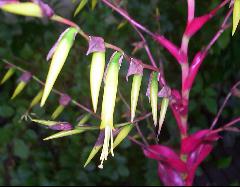
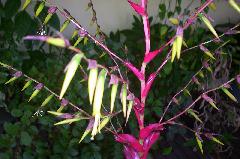
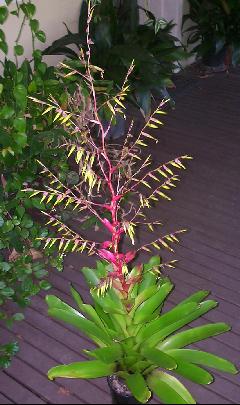

| Ian Hook 06/03 |
Ian Hooky 07/03 |
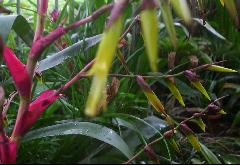
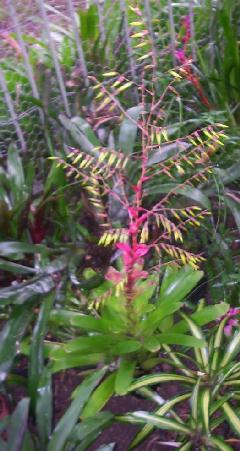
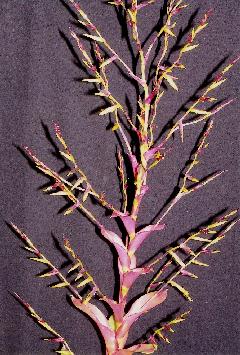
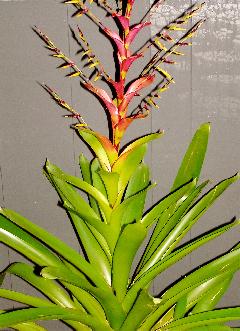
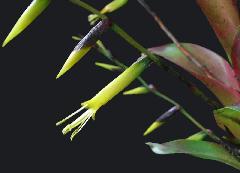
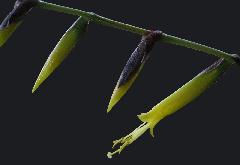
Ed. ... "There is a variegated form in circulation with registered cultivar name of 'Rafael'."
Vriesea philippocoburgii Wawra, Osterr. Bot. Zeitschr. 30: 219. 1880.
Tillandsia philippocoburgii (Wawra) Baker, Jour. Bot. London 26: 138. 1888.
Desc from S&D
Plant lacking rhizomes, flowering 1-3 m high.
Leaves very many in a dense spreading rosette, 5-8 dm long;
Sheaths elliptic, distinctly wider than the blades, dark purple toward apex, diffusely and minutely brown-lepidote;
Blades ligulate, broadly rounded, apiculate, 5-8 cm wide, usually green except for the dark purple apex, obscurely lepidote.
Scape erect, stout, much shorter than the leaves;
Scape-bracts densely imbricate, divergent, foliaceous, the upper bright red.
Inflorescence very laxly paniculate, much branched, nearly glabrous;
Primary bracts much shorter than the branches, the lower subfoliaceous, ample, the upper ovate, apiculate;
Branches suberect, lax, to 5 dm long, the lower divided and bearing sterile bracts at base; Rhachis slender, flexuous.
Floral bracts downwardly secund with the flowers, broadly ovate, acute, about equaling the middle of the sepals, straight, ecarinate, membranaceous, red; pedicels 5-10 mm long.
Sepals lanceolate or elliptic, broadly acute, to 25 mm long, ecarinate, yellow;
Petals linear, acute, 35-45 mm long, greenish toward apex, bearing 2 acute scales at base; Stamens exserted.
Capsule slender, slightly exceeding the sepals.
Type. Wawra II-1 (holotype W n v lost), Petropolis, Rio de Janeiro State, Brazil. In case no isotype is discovered, the species is well typified by Wawra's illustrations: It. Sax.-Cob. pl. 29, 37-A. 1883.
DISTRIBUTION. Saxicolous and epiphytic, coastal scrub to mountain cliffs and rain-forest, 2-1200 m alt, Rio de Janeiro State to Rio Grande do Sul in eastern Brazil. BRAZIL.
RIO DE JANEIRO: Petropolis. Mar 1887, Glaziou 16473 (P, US); 23 Nov 1928, L. B. Smith 1324 (GH); 22 May 1939, Foster 36 (GH, R, US); 10 Apr 1952, L. B. Smith & Mus R. 6497 (R, US); 27 jan 1968, L. B. Smith & McWilliams 15337 (MICH, R, US); Teresopolis, Sampaio s n (R); Soberbo to Guapi, Serra dos Orgiios, 18 Dec 1928, L. B. Smith 1526 (GH); Teodoro de Oliveira to Nova Friburgo, 20 Apr 1952, L. B. Smith & Mus R 6497 (R, US); Serra da Estrella, 25 Mar 1967, E. Pereira 10569 (HB, US). GUANABARA: Tijuca, 3 Apr 1875, Glaziou 8017 (P); Apr 1898, Ule 4673 (CORD, HBG); 23 Feb 1939, B. Lutz 1270 (R); Tijuca-Excelsior, 1 May 1939, B. Lutz 1447 (R); Morro Queimado, 2 Jun 1948, Duarte & Pereira s n (RB). SAO PAULO: Rio Buturoca, Santos, 5 Mar 1875, Mosen 3248 (C, R, S); Ramal Mayrink to Santos, 26 Oct 1934, Lamber in Servico P.E.F.S. 3 (SP); Alto da Serra, 20 Aug 1939, Foster 375 (GH, R); km 279, Sao Paulo to Curitiba (Parana), 24 Aug 1939, Foster 398 (GH); Paranapiacaba, 17 May 1956, Handro 577 (SP, US). PARANA: Jacarei, cult. 12 Mar 1910, Dusen s n (S); 9821 (S, US); 18 Feb 1916, 17704 (S, US); Matinhos, 1 Sep 1939, M. Kuhlmann s n (SP); Paranagua, 1 Sep 1939, Foster 443 (GH); Guaratuba, 21 Feb 1952, L. B. Smith & Reitz 5726 (R, US); Areia Branca, Sao Jose dos Pinhaes, 23 Nov 1957, Hatschbach 4309 (US); Sertaozinho, Paranagua, 10 Jun 1960, Hatschbach 7065 (US); Pedra Branca de Araraquara, Guaratuba, 10 Nov 1963, Hatschbach 9773 (US). SANTA CATARINA: Sornbrio, 14 Apr 1944, Reitz C-495 (GH, HBR); 22 Apr 1945, 1657 (HBR, S); 25 Apr 1945, C-1034 (HBR); Sanga d'Anta, Ararangua, 24 Mar 1945, Reitz C-1019 (GH, HBR); Carnpo dos Padres, Bom Retiro, Reitz 2634 (HBR); Rio das Contas, Sao Joaquim, Jan 1950, Reitz 3316 (HBR); Brusque, Reitz 3592 (HBR); Papanduva, Reitz 3981 (HBR); Caupe, Florianopolis, Inst. Malariologia s n (HBR); Ibirama, 1 Mar 1954, Reitz & Klein 1572 (HBR, US); Itajai, 18 Mar 1954, Reitz & Klein 1760 (HBR, US); Campo Alto, Santa Cecilia, 9 Dec 1962, Reitz & Klein 14228 (HBR, US); Morro do Ribeirao, Florianopolis, 18 Apr 1967, Klein 7337 (HBR). Rio Grande do Sul: Lagoa dos Quadros, Torres, 21 Feb 1950, Rambo s n (US).
Protologue
Vriesea Philippocoburgii n. sp. Wawra, Osterr. Bot. Zeitschr. 30: 219. 1880.
Glaberrima foliis dense rosulatis amplis integerrimis ad apicem fusco brunneum rotundato-obtusis ----- mucronatis; paniculae breviter stipitatae scapo squamis purpureis validis laxe
obtecto, ramis sanguineis erectis subsimplicibus; floribus distantibus horizontalibus secundis; bracteis scariosis e basi ovata protracte acuminatis apice plerumque tortis; calycis bracteam excedentis foliolis acutis aureis leviter convolutis; petalorum lamina subanthesi porrecta demum revoluta, filamentis breviter - post anthesin longissime exsertis; stylo stamina excedente demum longissimo, stigmate minuto trilobo; nectariis ad pet. basin geminis flavis granuloso-punctatis.
Folia 50 cm. longa, 6 cm. lata, subcoriacea laete viridia, prope basin purpureo maculata. Paniculae cum scapo digitum fere crasso metro parum brevioris rami stricti haud flexuosi, inferiores plerumque (semel) ramulosi, squamae scapinae coriaceae rotundatae caudato apiculatae fusco purpureae, rameales scapinis minores caeterum iis homomorphae; florum bracteae 2 - fere 3 cm. longae, rubiginosae. Calycis foliola 3 cm. longa coriacea lanceolata basi sordide viridia. Petalorum ungues convoluti angusti, laminae 1 cm. longae virescentes planae, post anthesin corrugatae et patentim revolutae; nectaria lanceolato trigona valde tenera, ovario adpressa; filamenta alternantia basi dilatata; antherae supra basin fissam dorso insertae, obtusae citrinae, sublitiliter transverse striolatae. Ovarium elongato-conicum. Capsula 4.5 cm. longa. Semina (haud matura) funiculo iis quadruplo longiore fibrillis ochraceis basi cincto sustenta, linearia rostello iis aequilongo superata.
Petropolis (Benod) Wwr, coll. l.
Eine prachtvolle, durch die blutrothen Rispen und die schmalen einseitswendigen d. h. nach aussen gekehrten Bluthen ausgezeichnete Pflanze; gehort gleichfalls in die Gruppe von V. regina; sie wachst auf freien, feuchten Felshugeln, wird auch haufig in den Garten von Petropolis cultivirt.
Updated 22/01/23













